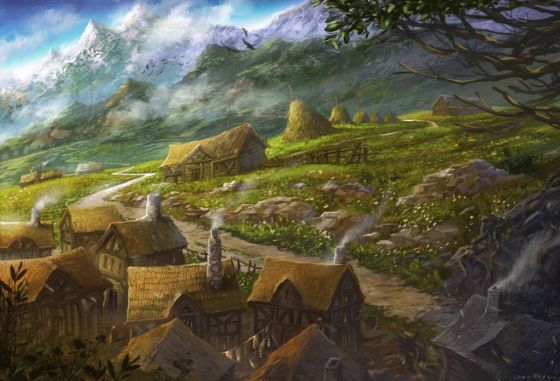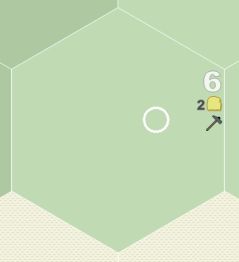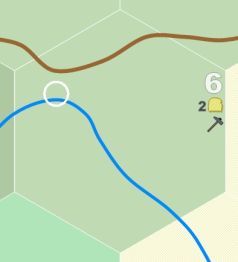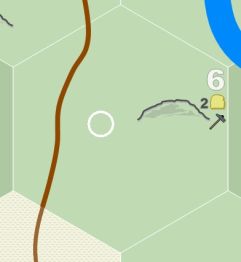Difference between revisions of "Communal Hamlet"
Tao alexis (talk | contribs) |
Tao alexis (talk | contribs) |
||
| (5 intermediate revisions by the same user not shown) | |||
| Line 1: | Line 1: | ||
[[File:Communal Hamlet.jpg|right|560px|thumb]] | [[File:Communal Hamlet.jpg|right|560px|thumb]] | ||
| − | '''Communal | + | '''Communal hamlets''' are clusters of rural dwellings that occur in Type-6 hexes, that lack the presence of significant [[River|rivers]] with 2 pts. or more. They are too small to be considered a [[Village|village]], but possess an organisation that places them above [[Thorp|thorps]]. They have a symbol designation that includes 2 [[Bread (symbol)|bread]] and 1 [[Hammer (symbol)|hammer]]. |
__TOC__ | __TOC__ | ||
[[File:6-2b.1h.jpg|left|30px|thumb]] | [[File:6-2b.1h.jpg|left|30px|thumb]] | ||
| − | Though they may occur in hexes with [[River#Stream|streams]], such places are largely dependent on groundwater [[Water Well|wells]]. Agrarian in nature, hamlets of this type are partly named because they adjoin [[Farmland|farmlands]] that are owned collectively, called into [[Communal Holding|communal holdings]]. The communities themselves are tight-knit, with strong traditional ties to the land, their ancestors and a shared [[Religion|religion]]. While the inhabitants are free, cultivation of the land is conducted by the people working together, with harvests demanding the most of a community that sees its survival depending on its cultural unification. | + | Though they may occur in hexes with [[River#Stream|streams]], such places are largely dependent on groundwater [[Water Well|wells]]. Agrarian in nature, [[Hamlet|hamlets]] of this type are partly named because they adjoin [[Farmland|farmlands]] that are owned collectively, called into [[Communal Holding|communal holdings]]. The communities themselves are tight-knit, with strong traditional ties to the land, their ancestors and a shared [[Religion|religion]]. While the inhabitants are free, cultivation of the land is conducted by the people working together, with harvests demanding the most of a community that sees its survival depending on its cultural unification. |
== Population == | == Population == | ||
| Line 55: | Line 55: | ||
</gallery> | </gallery> | ||
<br> | <br> | ||
| + | |||
| + | == Generator == | ||
| + | A generator for determining a communal hamlet's population and surrounding hex can be found here: [https://docs.google.com/spreadsheets/d/1d29Gd8Z81_-3jAPvCWmmtig_IQWt9KWk/edit#gid=1389687377&rtpof=true&sd=true generator]. | ||
| + | |||
See also,<br> | See also,<br> | ||
| + | [[Bread (symbol)]]<br> | ||
[[Coin (symbol)]]<br> | [[Coin (symbol)]]<br> | ||
| + | [[Hammer (symbol)]]<br> | ||
[[The Adventure]] | [[The Adventure]] | ||
[[Category: Facilities]] | [[Category: Facilities]] | ||
Latest revision as of 06:03, 5 September 2023
Communal hamlets are clusters of rural dwellings that occur in Type-6 hexes, that lack the presence of significant rivers with 2 pts. or more. They are too small to be considered a village, but possess an organisation that places them above thorps. They have a symbol designation that includes 2 bread and 1 hammer.
Though they may occur in hexes with streams, such places are largely dependent on groundwater wells. Agrarian in nature, hamlets of this type are partly named because they adjoin farmlands that are owned collectively, called into communal holdings. The communities themselves are tight-knit, with strong traditional ties to the land, their ancestors and a shared religion. While the inhabitants are free, cultivation of the land is conducted by the people working together, with harvests demanding the most of a community that sees its survival depending on its cultural unification.
Population
A communal hamlet is sure to include a garner, stable, water well, gong pit and between 11-13 hovels. This accounts for a minimum of 29-67 people. Additional persons are added by other facilities existing, as indicated by the table shown. Note that there are differences in the table shown from that appearing on the thorp table.
| Buildings | Population | Hovels | Presence |
|---|---|---|---|
| communal holding | 5d6+20 | 8-10 | always |
| garner | 2d4-1 | 1 | always |
| gong farmer | 1-2 | 1 | always |
| stable | 2d4 | 1 | always |
| ox tether & hovel | 2-4 | 1 | no road better than a cart path exists |
| saw pit & hovel | 2d4+3 | 2 | hamlet located in a forested range |
| shearing station | 2d4+1 | 1 | sheep reference |
| windmill | d4+d6 | 1 | located on barren, steppe or sea-side type-1 hex; see text |
Saw pits are supported by nearby woodcutters who maintain a hovel in the hamlet. Windmills may also occur if there hills in the hex, within a mile of the hamlet. There may be up to three windmills; a gristmill for certain; a fulling mill if a fibre, cloth or clothing reference exists; and a winepress if there are three references to grapes and wine. Millers and their families dwell in hovels near the windmill.
Altogether, the largest communal hamlets, which possess every possible facility, have 45-121 people (average 83) and 18-20 hovels. If the number is low, most will be adults. If high, most will be children. Facilities are as like to be provided by parent and offspring, siblings or married couples.
Leadership
Decisions within the communal hamlet are made by a council of elders, who ensure the residents maintain a traditional view of life. Community members belong to a single tribal group or clan; the prevalence of familial ties can become so strong that members must marry outside the hamlet. As marriages are arranged, it's common for several hamlets to respect agreements on these lines made by past generations.
Socage is paid jointly by all, helping to sustain every resident. Often it isn't paid at all, as the hamlet is often remote. Members of the community don't "own" their own land; land is communal. Even gardens planted in one's own yard. Debt is unheard of. Those to resent group authority, or make trouble, are dealt with through expulsion.
Within the barter economy, the garner is part of the community and therefore does not write notes payable to farmers within the hamlet. However, there are usually isolated farmers who deliver their goods, whose goods are paid for and records kept. Fees owed to the garner are owned by the whole community, with the elders determining how best to spend this money.
Hex Examples
In the examples of type-6 hexes shown below, from left to right
- 1) The hamlet exists in no particular place within the hex, but it has a watersource that it accesses through wells. Physical effort is needed to irrigate small areas by hand, but rainfall is usually sufficient to grow crops.
- 2) The hamlet exists on a small 1 pt. river, which is sufficient to provide waterpower needed for a fulling mill, but not a gristmill nor a boat dock. Note that in the example, the hamlet is near a road but not on it; access to the road would be provided by a simple path.
- 3) The hamlet possesses a singular hill that would allow for a windmill, even if the hamlet were largely covered by a forest. Being within a mile of the hill means that again, this hamlet is recessed from the road.
Generator
A generator for determining a communal hamlet's population and surrounding hex can be found here: generator.
See also,
Bread (symbol)
Coin (symbol)
Hammer (symbol)
The Adventure



